Insight into the World of Detergents
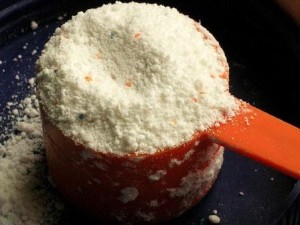 The timeline of production of synthetic detergent dates back to the time of World War-I, when there was an acute shortage of the essential ingredients of soap i.e. animal fats and vegetable oil, it was then that in Germany, synthetic detergent was developed for the first time. The advantage of using synthetic detergent was that it not only better suited the textile industry but also did not combine with mineral salts present in water to form soap curd which was an insoluble residue formed on the surface of the fabric and hence was a better option for washing than soaps in hard water. As for India, the detergent industry entered somewhere around in 1957 when the Swastik Oil Mills in Wadala, Mumbai established the first ever detergent factory of the country, which though used imported ingredients yet was less expensive for the people than the imported finished products.
The timeline of production of synthetic detergent dates back to the time of World War-I, when there was an acute shortage of the essential ingredients of soap i.e. animal fats and vegetable oil, it was then that in Germany, synthetic detergent was developed for the first time. The advantage of using synthetic detergent was that it not only better suited the textile industry but also did not combine with mineral salts present in water to form soap curd which was an insoluble residue formed on the surface of the fabric and hence was a better option for washing than soaps in hard water. As for India, the detergent industry entered somewhere around in 1957 when the Swastik Oil Mills in Wadala, Mumbai established the first ever detergent factory of the country, which though used imported ingredients yet was less expensive for the people than the imported finished products.
Synthetic detergents are non- soapy cleaning agents synthesized chemically. They are polar amphiphilic compounds with a polar sulphonate head containing synthetic surfactant material, builder and additives like bleach, water softners, enzymes, etc. The detergents developed initially were short chain alkyl naphthalene sulphonates whose properties were worked on and improved upon later on. Towards the end of World War-II, the market was swamped by alkyl aryl sulphonates over alcohol sulphates, which were later found to be very useful for the shampoo industry. Detergents are usually alkylbenzenesulphonates and can be categorized (chemically) as follows-
- Anionic- As the name suggests anionic detergents produce anionic or negative colloidal ions that are neutralized by a basic or alkaline particle in the solution to produce complete detergency. They are produced from weak acids and strong alkalis. Anionic detergents can be long chain alcohol sulphates, alkyl aryl sulphonates, etc. Anionic detergents are very commonly used as car wash, in shampoos, powdered laundry detergent, etc. Dodecyl benzene sulphonic acid acts as an anionic detergent base, which is neutralized by bases like sodium hydroxide, potassium hydroxide, etc.
- Cationic- These produce positive ions in solution and are manufactured by a combination of strong acid and weak alkali and hence are slightly acidic in nature. They produce low foam and have anti static properties, which would mean that the positive charge on the cationic detergent repels the like charge on the dust particle. Having low detergency properties these are preferentially used as fabric softeners, germicides, disinfectants, etc.
- Non ionic- Non ionic types of detergents don’t ionize when dissolved in water and are neutral in nature because they are manufactured using acids and alkalis of similar strengths. They have low foam properties and can be used with anionic detergents as foam boosters. They are effective in cleansing oil and grease and have higher efficiency than anionic detergents in hard water.
- Amphoteric- they are relatively expensive detergents having both acidic and basic groups, which can act like cationic (pH <4), anionic (pH >=8) and non ionic (pH between 6 and 8) detergents depending on the pH. Its detergency reduces at lower pH and they work best in neutral conditions. They are therefore, used in shampoos, skin cleansers, etc.
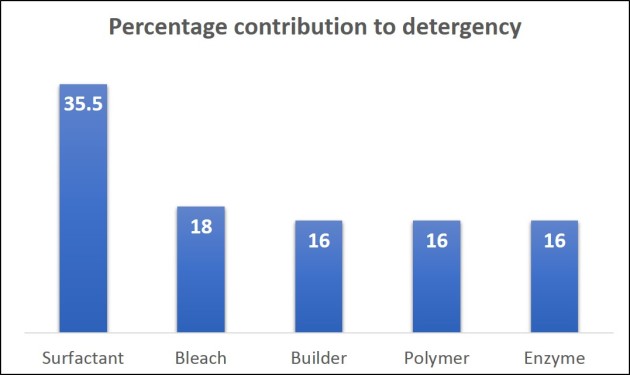
Three forces are required for effective cleaning:
- Mechanical energy which can be provided manually or via machines.
- Thermal energy provided in the form of warm water and lastly,
- Chemical energy from the detergent. Detergents bulk components include bleach, polymer, builder, enzyme and surfactant. Surfactants are mainly responsible for the cleansing action of the detergent. The relative contribution of these components in cleaning the dirt off the fabric is given in figure 1.
The surfactant in the detergent contains a hydrophobic (water repelling) tail and hydrophilic (having affinity towards water) head, which reduces the surface tension of water and the interfacial tension between water and oil, hence cleaning the dirt off the fabric by one of the following three mechanisms
- Roll up mechanism- The mechanism involves the formation of a ball like structure known as micelle, with the hydrophilic head facing the water surface and the hydrophobic tail dug inwards towards the oil/grease, hence the oil and grease trapped inside the micelle in suspension can be washed off.
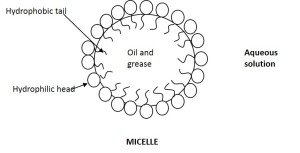
- Solubilization- This mechanism is similar to the roll up mechanism, applicable when there are either too many or stubborn stains. The micelle in this case breaks off the dirt from the surface a bit at a time until the dirt is completely removed.
- Electrostatic interactions- The anionic surfactant deposits on the surface of the stain increasing the charge density causing electrostatic repulsion thus inhibiting the dirt to redeposit hence enhancing the cleansing action.
Detergents contain different ingredients serving different purposes. The main ingredients in a detergent are – Plasticizers and binders (20-50%), Surfactants (30-70%), Fillers and binders (5-30%), Water (5-12%), Lather enhancers (0-5%), Fragrance (0-3.0%), Dyes and pigments (less than 1%), Opacifying agents (0-0.3%)
Other specific ingredients like glycerin, anti microbial agents may also be present according to the requirement. The typical composition of detergent bar and powder is-
| High priced powder | Medium priced powder | Low priced powder | High priced bar | Low priced bar | |
| Active matter | 15-18% | 11-14% | 8-10% | 18-20 | 12-15 |
| Phosphates/Zeolites | 15-20% | 5-8% | Nil | 10-15 | 5-15 |
| Soda-ash | 5-10% | 12-20% | 30-70% | Nil | 5-15 |
| Sodium silicate | 4-5% | 15-30% | Nil | – | – |
| Sodium Sulphate | 24-40% | 23-36% | 3-5% | 2-3 | 2-3 |
| Sodium Chloride | Nil | Nil | 7-50% | 5-10 | 10-20 |
| Clay | Nil | 15-20% | 10-20% | 30-50 | 40-60 |
| Moisture | 8-10% 1 | 0-15% | 15-20% | 5-10 | 10-12 |
| Starch/ | 10-15 | 5-10 | |||
| Wax | 1-3 | 0-2 |
Source- http://www.vigyanprasar.gov.in/chemistry_application_2011/briefs/soaps_and_detergents.pdf
Effects of Detergents on Health and Environment
These artificial fragrances, brighteners, surfactants used in detergents have almost replaced the use of soaps in laundry which were originally mostly natural in its composition containing fats and oils. These chemicals pose a potential risk to humans and can also harm the environment. The potential impacts of these ingredients can be tabulated as below-
| Detergent constituents | Chemicals involved | Function | Environmental effect / Biodegradability* | Health toxicity |
| Surfactants | Alkyl benzene sulfonates (ABS) or Linear alkyl benzene sulfonates | Wetting, emulsifying and dispersing properties, enable removal of dirt (‘soil’) from fabrics keep the soil suspended in the washing water. | Manufacturing process emits Benzene, a known carcinogen and reproductive toxin. | Causes slight to moderate eye and skin irritation. |
| Surfactants | Alkyl phenoxy polyethoxy ethanol or nonyl phenol | Same as above. | Are toxic to aquatic organisms | Is a suspected endocrine toxicant |
| Surfactants | Diethanolamines | Same as above. | Are slow to biodegrade | Cause cancer. React with natural nitrogen oxides and sodium nitrite pollutants in the atmosphere to form nitrosamines, a family of potent carcinogens |
| Builders | Sodium tripolyphosphate (STPP) | Removes hard water minerals like calcium and magnesium ions to increase effectiveness of detergents. Act as deflocculating agents to prevent dirt redeposition. | Contribute to eutrophication of waterways
Are biodegradable |
– |
| Builders | Ethlene-diamino- tetra-acetate (EDTA), a phosphate- alternate compound | Reduces calcium and magnesium hardness in water. Also prevents bleaching agents from becoming active before immersion in water | – | Short term exposure can cause eye and skin irritation. |
| Anti-redeposition agents | Polyethylene glocol (PEG) | Prevents dirt from settling back onto clothes. | – | Is a suspected skin or sense organ toxicant. |
| Optical brighteners | Chlorine bleach or sodium hypochlorite | Convert UV light wavelengths to visible light, thus making laundered clothes appear ‘whiter’. | Is toxic to aquatic organisms. Can cause allergic reaction when in contact with skin, and is also an eye and lung irritant | |
| Artificial fragrances | Made from petroleum products | Provide a fragrant odour to clothes after washing | Bio-accumulative | – |
Source- http://toxicslink.org/docs/06031_Detergent_Factheet_English.pdf
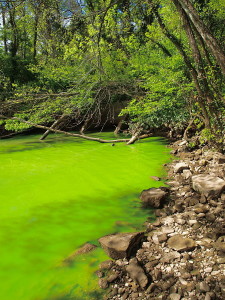
Detergents contain phosphates which are used to stabilize the alkalinity of the surfactants, and to prevent the resettling of dirt on the fabric and softening of hard water. The detergent containing phosphates on finding its way into the waterways portend a very grim situation of water pollution and eutrophication. Eutrophication is the increase in algal growth in a water body due to the increased nutrient content, mostly nitrates and phosphates; the enhanced algal growth reduces the transparency of the water body and also the dissolve oxygen level hence bringing about death of fishes and other underwater aquatic species. In India, there is no regulation on the level of phosphorus in detergents although the per capita demand of detergents is rising in the country unlike Canada, where phosphorus content was limited to 0.5% in the laundry detergents as a response to the increasing risk due to the detergents. Though phosphorus and phosphine have been categorized as toxic under the Environmental Protection Act, 1986 and Hazardous waste rules, there is still no regulation as the rules don’t apply to household detergents. Cationic detergents have biocidal properties, disrupting cellular activities killing many useful bacteria in sewerage treatment. Also, the surfactants present in detergents that help in dirt drop out are toxic to the aquatic system. They persist in the environment for long and even after breaking down, produce additional byproducts which are in turn toxic, as well. The surfactants break down the mucus protective layer of the fish that protects them from bacteria and parasites and are also known to disrupt the endocrine systems of animals and humans other than decreasing the rate of breeding in aquatic organisms.
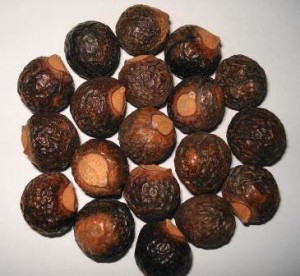
According to Novozyme researchers, replacements of surfactants with multi-enzyme solution is a more environmentally sustainable solution, without compromising on the performance of the detergent as they are less toxic, enable compaction and saves energy. Consumers too can play an important role in reducing the impacts on the environment. The optimal use of detergents and natural cleansing products is a contribution required from environmentally conscious and aware consumers. The use of naturally occurring material like Sapindus mukorossi, popularly known as reetha in India is a safe option over the chemicals used in synthetic detergents. It is known to create no obnoxious smell, is environmentally safe and also has no health implications like allergies.
Homemade detergents can also be prepared using easily available ingredients like bar soaps, baking soda, lemon essential oil, vinegar, peroxide (optional) in a few simple steps. Natural products should be encouraged giving an incentive for further research and involvement of more companies to produce environmentally safe products. Some of these products available in India are-
- Krya Natural Detergent Powder– It is a petroleum free product without any artificial additive made from certified sun ripened soapberries that can be used for both top loading and front loading washing machines.
- Bio D Bar– Bio D bar of the daily dump brand in Bangalore is a bio detergent produced from palm oil. They also have a product called Vanastree Soapnut scrub, which is a natural product for cleaning utensils made from shikakai (Acacia concinna), soapnut (Sapindus mukorossi) and lemon peels.
- Bio Liquid Laundry– This product from Rustic Art, a PETA certified brand in Maharashtra is a biodegradable, handmade and sans foam containing glycerine for conditioning the clothes. They also have a chlorine free kit for laundry.
Synthetic detergents have been in use since ages but they are definitely not a man’s best friend. It is important to understand that these chemicals would never do us any good, hence, one should decrease their use. The soiled patches should be removed before dumping it, white clothes should be sun dried as it also kills a lot of bacteria, amount of detergent used should also be reduced, the paste prepared from detergent, white vinegar and baking soda can be used to brush off the stains, clothes should be washed in cold water, daily wear clothes should be washed with minimal amount of detergents possible, soapnuts can be used as a natural detergent, a combination of salt, baking soda and vinegar can effectively reduce even very tough stains. Hence, a little awareness and responsibility towards environment will go a long way in promoting a sustainable lifestyle.
References:
http://articles.economictimes.indiatimes.com/2012-01-15/news/30627880_1_detergents-powder-business-vegetable-oils
http://www.detergentsandsoaps.com/detergents-history.html
http://www.gsa.gov/portal/content/113006
http://www.chemistry.co.nz/detergent_class.htm
http://www.detergentsandsoaps.com/detergent-ingredients.html
http://www.downtoearth.org.in/interviews/detergents-threaten-indias-waterbodies-16470
http://www.livestrong.com/article/151779-environmental-impacts-of-detergent/
http://nsb.wikidot.com/c-9-5-5-12
http://www.mnn.com/your-home/at-home/stories/eco-friendly-laundry-tips
National qualifications curriculum support, Learning and Teaching Scotland 2011
Image credit:
Detergent, Eutrophication, Reetha



